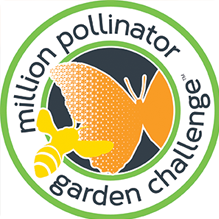Million Pollinator Garden Challenge Tops Goal
In the past three years, 1,040,000 gardens have been registered with the Million Pollinator Garden Challenge (MPGC), involving an estimated 8 million people, concentrated in the U.S. and Canada with some in Mexico and across the globe.
From tiny yards to public gardens, the million plus gardens add up to a network of approximately 5 million acres of enhanced or new pollinator habitat.
 Pollinator Gardening Hot Spots, where high percentages of the local population registered gardens, include: the desert southwest, Santa Fe, New Mexico, Prescott and Flagstaff, and the Phoenix-Mesa-Scottsdale, Arizona metro area. The Smoky Mountain region, which straddles North Carolina and Tennessee, contributed over 35,000 gardens. These areas, along with St. Louis, Missouri and others also support high bee density and diversity. Research indicates that the impact of these small-scale pollinator gardens has added significant support to pollinator abundance and diversity.
Pollinator Gardening Hot Spots, where high percentages of the local population registered gardens, include: the desert southwest, Santa Fe, New Mexico, Prescott and Flagstaff, and the Phoenix-Mesa-Scottsdale, Arizona metro area. The Smoky Mountain region, which straddles North Carolina and Tennessee, contributed over 35,000 gardens. These areas, along with St. Louis, Missouri and others also support high bee density and diversity. Research indicates that the impact of these small-scale pollinator gardens has added significant support to pollinator abundance and diversity.
Metro areas with the highest number of registered gardens include Atlanta, Chicago, Miami-Ft. Lauderdale, Philadelphia-Camden, Washington D.C. and New York City.
Launched in June 2015 by the National Pollinator Garden Network (NPGN), the goal of the MPGC was to create networks of gardens to help save pollinators, which are responsible for one out of three food bites we take each day.
“Together, through collaborative conservation we are restoring pollinator populations that provide the foundation of our ecosystems and our food supply.” said Collin O’Mara, president and CEO of National Wildlife Federation. “When we save wildlife, we save ourselves”.
Co-founding organizations — National Wildlife Federation; Pollinator Partnership; American Public Gardens Association; AmericanHort; National Gardening Association; American Seed Trade Association; National Garden Bureau; and KidsGardening.org — led the doubling of the NPGN to over 50 conservation, garden trade, garden club, and voluntary civic and federal partners.
An impact report indicates the MPGC led to a shift in consumer awareness, and wider actions such as pro-pollinator pledges, proclamations and policies. Since the campaign launch, 92 percent of garden centers have seen an increase in demand for pollinator-friendly plants and services and 86 percent are offering more pollinator-friendly plants, services, and education. Craig Regelbrugge, senior vice president of AmericanHort, applauds these efforts. “Leaders in horticulture have stepped up to meet consumer demand for pollinator friendly plants and to provide the necessary education about sustainable methods that support habitat.”
Moving Forward
The 2019 call to action is designed to build on the momentum of Challenge in two ways: 1) Expanding garden habitat by asking Americans to plant at least three different pollinator-friendly plants that bloom in three different seasons (spring, summer and fall) to help ensure a consistent food supply for pollinators. The MPGC map will stay open for new registrations, and plant/garden descriptions. 2) Track the outcomes of this movement, by encouraging everyone to participate in citizen science projects that help pollinators at https://www.scistarter.org/pollinatorgardens.


 Video Library
Video Library 




















